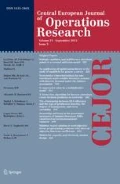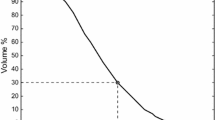Abstract
Intensity Modulated Radiotherapy Treatment (IMRT) is a technique used in the treatment of cancer, where the radiation beams are modulated by a multileaf collimator allowing the irradiation of the patient using non-uniform radiation fields from selected angles. Beam angle optimization consists in trying to find the best set of angles that should be used in IMRT planning. The choice of this set of angles is patient and pathology dependent and, in clinical practice, most of the times it is made using a trial and error procedure or simply using equidistantly distributed angles. In this paper we propose a genetic algorithm that aims at calculating good sets of angles in an automated way, given a predetermined number of angles. We consider the discretization of all possible angles in the interval [0\(^{\circ }\), 360\(^{\circ }\)], and each individual is represented by a chromosome with 360 binary genes. As the calculation of a given individual’s fitness is very expensive in terms of computational time, the genetic algorithm uses a neural network as a surrogate model to calculate the fitness of most of the individuals in the population. To explicitly consider the estimation error that can result from the use of this surrogate model, the fitness of each individual is represented by an interval of values and not by a single crisp value. The genetic algorithm is capable of finding improved solutions, when compared to the usual equidistant solution applied in clinical practice. The genetic algorithm will be described and computational results will be shown.














Similar content being viewed by others

Notes
These tests were performed using the fit distribution option of software @Risk.
References
Aleman D, Romeijn H, Dempsey J (2006) A response surface-based approach to beam orientation optimization in IMRT treatment planning. IIEAnnual conference exposition, Orlando, FL, pp 6–11
Aleman DM, Kumar A, Ahuja RK, Romeijn HE, Dempsey JF (2008) Neighborhood search approaches to beam orientation optimization in intensity modulated radiation therapy treatment planning. J Glob Optim 42(4):587–607
Bevilacqua V, Mastronardi G, Piscopo G (2007) Evolutionary approach to inverse planning in coplanar radiotherapy. Image Vis Comput 25(2):196–203
Bortfeld T, Schlegel W (1993) Optimization of beam orientations in radiation therapy: some theoretical considerations. Phys Med Biol 38(2):291–304
Cheong K, Suh T, Romeijn H, Li J, Dempsey J (2005) Fast nonlinear optimization with simple bounds for IMRT planning. Med Phys 32:1975–1975
Craft D (2007) Local beam angle optimization with linear programming and gradient search. Phys Med Biol 52(7):N127–N135
Craft DL, Halabi TF, Shih HA, Bortfeld TR (2006) Approximating convex Pareto surfaces in multiobjective radiotherapy planning. Med Phys 33:3399–3407
D’Souza W, Meyer RR, Shi L (2004) Selection of beam orientations in intensity-modulated radiation therapy using single-beam indices and integer programming. Phys Med Biol 49(15):3465–3481
Das SK, Marks LB (1997) Selection of coplanar or noncoplanar beams using three-dimensional optimization based on maximum beam separation and minimized nontarget irradiation. Int J Radiat Oncol Biol Phys 38(3):643
Deasy J, Lee EK, Bortfeld T, Langer M, Zakarian K, Alaly J, Zhang Y, Liu H, Mohan R, Ahuja R (2006) A collaboratory for radiation therapy treatment planning optimization research. Ann Oper Res 148(1): 55–63
Deasy JO, Blanco AI, Clark VH (2003) CERR: a computational environment for radiotherapy research. Med Phys 30:979–985
Djajaputra D, Wu Q, Wu Y, Mohan R (2003) Algorithm and performance of a clinical IMRT beam-angle optimization system. Phys Med Biol 48(19):3191–3212
Ehrgott M, Holder A, Reese J (2008) “Beam selection in radiotherapy design”. Linear Algebra Appl 428:1272–1312
Ehrgott M, Johnston R (2003) Optimisation of beam directions in intensity modulated radiation therapy planning. OR Spectr 25(2):251–264
El-Beltagy MA, Keane AJ (1999) Metalmodeling techniques for evolutionary optimization of computationally expensive problems: promises and limitations. In: Proceedings of the genetic and evolutionary computation conference, Orlando, USA, pp 196–203
Emmerich M, Giotis A, Özdemir M, Bäck T, Giannakoglou K (2002) Metamodel-assisted evolution strategies. Parallel problem solving from nature PPSN VII. Springer, Berlin
Fiege J, McCurdy B, Potrebko P, Champion H, Cull A (2011) PARETO: a novel evolutionary optimization approach to multiobjective IMRT planning. Med Phys 38:5217–5229
Goitein M, Abrams M, Rowell D, Pollari H, Wiles J (1983) Multi-dimensional treatment planning: II. Beam’s eye-view, back projection, and projection through CT sections. Int J Radiat Oncol Biol Phys 9(6):789–797
Goodband JH, Haas OCL (2008) Artificial neural networks in radiation therapy. In: Haas OCL, Burnham KJ (eds) Intelligent and adaptive systems in medicine. Taylor & Francis, UK
Gulliford SL, Webb S, Rowbottom CG, Corne DW, Dearnaley DP (2004) Use of artificial neural networks to predict biological outcomes for patients receiving radical radiotherapy of the prostate. Radiother Oncol 71(1):3–12
Haas OCL, Burnham KJ, Mills JA (1998) Optimization of beam orientation in radiotherapy using planar geometry. Phys Med Biol 43:2179–2193
Haas OCL, Reeves CR (2005) Genetic algorithms in radiotherapy. Stud Multidiscip 3:447–482
Han J, Kamber M (2006) Data mining: concepts and techniques. Morgan Kaufmann, Burlington
Holdsworth C, Kim M, Liao J, Phillips MH (2010) A hierarchical evolutionary algorithm for multiobjective optimization in IMRT. Med Phys 37:4986–4997
Hüsken M, Jin Y, Sendhoff B (2005) Structure optimization of neural networks for evolutionary design optimization. Soft Comput A Fusion Found Methodol Appl 9(1):21–28
Jin Y, Branke J (2005) Evolutionary optimization in uncertain environments-a survey. Evol Comput IEEE Trans 9(3):303–317
Jin Y, Olhofer M, Sendhoff B (2002) A framework for evolutionary optimization with approximate fitness functions. Evol Comput IEEE Trans 6(5):481–494
Jin Y, Sendhoff B (2004) Reducing fitness evaluations using clustering techniques and neural network ensembles. Genetic and Evolutionary Computation GECCO. Springer, Seattle
Kalantzis G, Vasquez-Quino LA, Zalman T, Pratx G, Lei Y (2011) Toward IMRT 2D dose modeling using artificial neural networks: A feasibility study. Med Phys 38:5807–5817
Knezevic A (2008) Overlapping confidence intervals and statistical significance. StatNews #73. http://www.cscu.cornell.edu/news/statnews/stnews73.pdf. Accessed 14th January 2013
Knowles J, Gorne D, Bishop M (1998) Evolutionary training of artificial neural networks for radiotherapy treatment of cancers. IEEE World Congress on Computational Intelligence, pp 398–403, Alasca
Lahanas M, Schreibmann E, Milickovic N, Baltas D (2003) Intensity modulated beam radiation therapy dose optimization with multiobjective evolutionary algorithms. Evolutionary multi-criterion optimization, second international conference, pp 70–70, Springer, Faro, Portugal
Lee EK, Fox T, Crocker I (2003) Integer programming applied to intensity-modulated radiation therapy treatment planning. Ann Oper Res 119(1):165–181
Lee EK, Fox T, Crocker I (2006) Simultaneous beam geometry and intensity map optimization in intensity-modulated radiation therapy. Int J Radiat Oncol Biol Phys 64(1):301–320
Lei J, Li Y (2008). A DNA genetic algorithm for beam angle selection in radiotherapy planning. Cybernetics and Intelligent Systems, 2008 IEEE conference on, IEEE, pp 1331–1336
Li Y, Lei J (2010) A feasible solution to the beam-angle-optimization problem in radiotherapy planning with a DNA-based genetic algorithm. Biomed Eng IEEE Trans 57(3):499–508
Li Y, Yao D (2006) Accelerating the radiotherapy planning with a hybrid method of genetic algorithm and ant colony system. Lect Notes Comput Sci 4222:340–349
Li Y, Yao D, Yao J, Chen W (2005) A particle swarm optimization algorithm for beam angle selection in intensity-modulated radiotherapy planning. Phys Med Biol 50:3491
Li Y, Yao D, Zheng J, Yao J (2006) A modified genetic algorithm for the beam angle optimization problem in intensity-modulated radiotherapy planning. Artif Evol 97–106
Li Y, Yao J, Yao D (2004) Automatic beam angle selection in IMRT planning using genetic algorithm. Phys Med Biol 49:1915
Lim GJ (2008). Introduction to radiation therapy planning optimization. In: Lim GJ, Lee EK (eds) Optimization in medicine and biology. Auerbach Publications, Taylor & Francis Group, LLC, pp 197–221
Lim GJ, Cao W (2012) A two-phase method for selecting IMRT treatment beam angles: Branch-and-Prune and local neighborhood search. Eur J Oper Res 217(3):609–618
Liu HH, Jauregui M, Zhang X, Wang X, Dong L, Mohan R (2006) Beam angle optimization and reduction for intensity-modulated radiation therapy of non-small-cell lung cancers. Int J Radiat Oncol Biol Phys 65(2):561
Llacer J, Li S, Agazaryan N, Promberger C, Solberg TD (2009) Non-coplanar automatic beam orientation selection in cranial IMRT: a practical methodology. Phys Med Biol 54:1337–1368
Lu HM, Kooy HM, Leber ZH, Ledoux RJ (1997) Optimized beam planning for linear accelerator-based stereotactic radiosurgery. Int J Radiat Oncol Biol, Phys 39(5):1183–1189
Mathieu R, Martin E, Gschwind R, Makovicka L, Contassot-Vivier S, Bahi J (2005) Calculations of dose distributions using a neural network model. Phys Med Biol 50:1019–1028
Nazareth DP, Brunner S, Jones MD, Malhotra HK, Bakhtiari M (2009) Optimization of beam angles for intensity modulated radiation therapy treatment planning using genetic algorithm on a distributed computing platform. J Med Phys Assoc Med Phys India 34(3):129
Pugachev A, Xing L (2001a) Computer-assisted selection of coplanar beam orientations in intensity-modulated radiation therapy. Phys Med Biol 46(9):2467–2476
Pugachev A, Xing L (2001b) Pseudo beam’s eye-view as applied to beam orientation selection in intensity-modulated radiation therapy. Int J Radiat Oncol Biol Phys 51(5):1361–1370
Pugachev A, Xing L (2002) Incorporating prior knowledge into beam orientaton optimization in IMRT. Int J Radiat Oncol Biol Phys 54(5):1565–1574
Rocha H, Dias J, Ferreira BC, Lopes MC (2012) Selection of intensity modulated radiation therapy treatment beam directions using radial basis functions within a pattern search methods framework. J Glob Optim. doi: 10.1007/s10898-012-0002-5
Romeijn HE, Ahuja RK, Dempsey JF, Kumar A, Li JG (2003) A novel linear programming approach to fluence map optimization for intensity modulated radiation therapy treatment planning. Phys Med Biol 48(21):3521–3542
Rowbottom CG, Webb S, Oldham M (1999) Beam-orientation customization using an artificial neural network. Phys Med Biol 44:2251–2262
Schreibmann E, Lahanas M, Xing L, Baltas D (2004) Multiobjective evolutionary optimization of the number of beams, their orientations and weights for intensity-modulated radiation therapy. Phys Med Biol 49(5):747–770
Shanker M, Hu MY, Hung MS (1996) Effect of data standardization on neural network training. Omega 24(4):385–397
Stein J, Mohan R, Wang XH, Bortfeld T, Wu Q, Preiser K, Ling CC, Schlegel W (1997) Number and orientations of beams in intensity-modulated radiation treatments. Med Phys 24:149–160
Vasseur A, Makovicka L, Martin Ã, Sauget M, Contassot-Vivier S, Bahi J (2008) Dose calculations using artificial neural networks: a feasibility study for photon beams. Nucl Instrum Methods Phys Res Sect B Beam Interact Mater Atoms 266(7):1085–1093
Wells DM, Niederer J (1998) A medical expert system approach using artificial neural networks for standardized treatment planning. Int J Radiat Oncol Biol Phys 41(1):173–182
Willoughby TR, Starkschall G, Janjan NA, Rosen II (1996) Evaluation and scoring of radiotherapy treatment plans using an artificial neural network. Int J Radiat Oncol Biol Phys 34(4):923–930
Witten IH, Frank E (2005) Data mining: practical machine learning tools and techniques. Morgan Kaufmann, San Francisco, CA
Wu X, Zhu Y, Dai J, Wang Z (2000) Selection and determination of beam weights based on genetic algorithms for conformal radiotherapy treatment planning. Phys Med Biol 45:2547–2558
Acknowledgments
This work was supported by FEDER funds through the COMPETE program, by iCIS (CENTRO-07-ST24-FEDER-002003), and Portuguese funds through FCT—Fundação para a Ciência e a Tecnologia, under project PTDC/EIA-CCO/121450/2010 and by FCT under project grant PEst-C/EEI/UI0308/2011. The work of H. Rocha was supported by the European social fund and Portuguese funds.
Author information
Authors and Affiliations
Corresponding author
Rights and permissions
About this article
Cite this article
Dias, J., Rocha, H., Ferreira, B. et al. A genetic algorithm with neural network fitness function evaluation for IMRT beam angle optimization. Cent Eur J Oper Res 22, 431–455 (2014). https://doi.org/10.1007/s10100-013-0289-4
Published:
Issue Date:
DOI: https://doi.org/10.1007/s10100-013-0289-4



